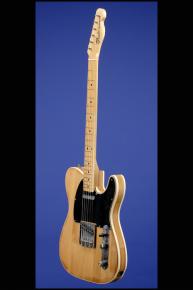Super Rare Maple-Cap Custom Telecaster
This forty-one year-old Natural Custom beauty weighs just 7.10 lbs. and has a nut width of just under 1 5/8 inches and a scale length of 25 1/2 inches. Solid alder body, single-bound on the top and the back. One piece maple neck, with a maple-cap fretboard and a wonderful medium-to-thick profile with 21 frets and black dot position markers. Single "butterfly" string tree. Headstock decal with "Fender" logo in gold with black trim, "Telecaster" in black below it, and "PAT. 2,573,254 3,143,028" in black below that. Individual Fender "F" tuners with octagonal metal buttons. The neck is stamped "3 JAN 68B" and the bottom of the neck is stamped "C 801" & B 804" and the neck cavity is stamped "C 801" & "B 765". Four-bolt neck plate with large Fender backward "F" logo and with serial number ("219851") between the top two screws. One plain metal-cover pickup (at neck) with an output of 5.56k and one black six-polepiece pickup with staggered polepieces (angled in bridgeplate) with an output of 6.14k. The potentiometers are stamped "137 6642" (CTS October 1966). Three-layer (black/white/black) plastic pickguard with eight screws. Two controls (one volume, one tone) plus three-way pickup selector switch with "top-hat" tip, all on metal plate adjoining pickguard. Chrome knobs with flat tops and knurled sides. Telecaster combined bridge/tailpiece with three steel saddles. This wonderfully light Tele Custom was originally finished in three-tone sunburst and was sent back to the factory by the original owner to be refinished in Natural. This was done sometime between 1969 and 1972, as the guitar was at that time fitted with the rare triple-ply (black/white/black) pickguard that was used only on the Rosewood Telecaster which was only in production from 1969 to 1972 (see A.R. Duchossoir, The Fender Telecaster, pp. 25 and 42). On the body under the pickguard is stamped the number "5" -- the Fender refin stamp. All of the solder joints are Fender factory original and as previously stated there are matching factory stamps on the neck and the body. Apart from some very minor finish checking, some slight cracks in the binding on the treble side of the body, and a few very tiny surface marks, this is a wonderful example in excellent plus (8.75) condition, with an almost unplayed maple-cap neck. Housed in the original black hardshell case with dark orange plush lining (8.75).
"Leo Fender's new solidbody was the instrument that we know now as the Fender Telecaster, effectively the world's first commercially successful solidbody electric guitar...The guitar was originally named the Fender Esquire and then the Fender Broadcaster, and it first went into production in 1950. It was a simple, effective instrument. It had a basic, single-cutaway, solid slab of ash for a body, with a screwed-on maple neck. Everything was geared to easy production. It had a slanted pickup mounted into a steel bridge-plate carrying three adjustable bridge-saddles, and the body was finished in a yellowish color known as blond. It was unadorned and like nothing else. It was ahead of its time. (Tony Bacon, 50 Years of Fender, p. 10).
"After a false start the Esquire reappeared...in 1951, now with Fender's new adjustable truss-rod. It was offered in single-pickup format only, but otherwise was virtually identical to the two-pickup Telecaster. However, the Esquire's three-way selector functioned as a preset tone control or bypass switch, offering wide versatility from a one-pickup guitar. Perhaps surprisingly, the Esquire stayed in the line for 20 years" (Tony Bacon and Paul Day, The Fender Book, p. 10).
"The June 1959 NAMM convention held in New York saw the debut of the TELECASTER and ESQUIRE CUSTOM. Intended as a deluxe version of the regular models, they were characterized by what Fender called 'the custom treatment of the body,' i.e. a sunburst finish with a contrasting white binding and a triple-ply white pickguard. Otherwise, with the exception of an alder body, their basic appointments were identical to the mid-59 'standard' Telecaster and Esquire models" (A.R. Duchossoir, The Fender Telecaster, pp. 19-20).
Translate:









